Mastering Butter Scones: A Detailed Guide

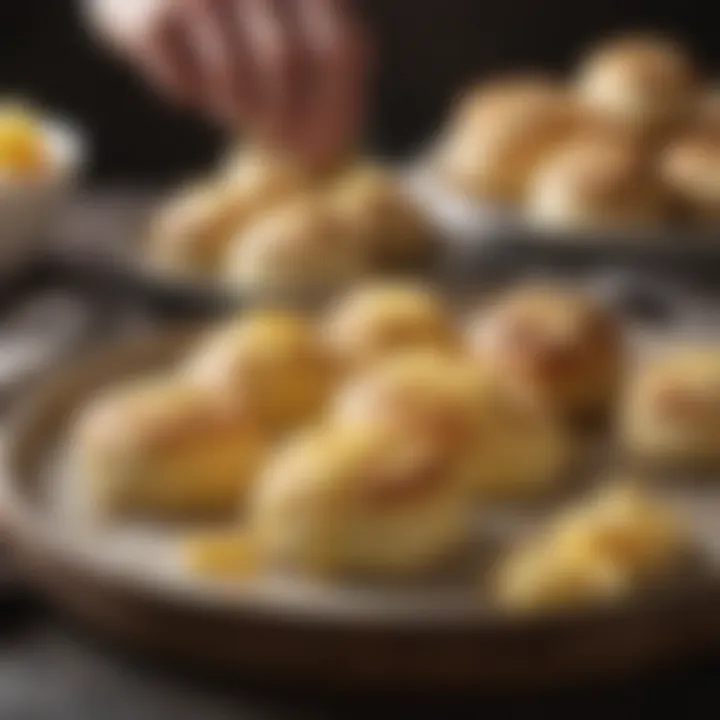
Intro
Scones, a delightful baked treat, often evoke images of quaint tea rooms and sunny afternoons. They are more than just pastries; they hold a beautiful heritage in the realm of comfort food. Making the perfect scone, particularly with rich butter, elevates this classic biscuit into a culinary masterpiece.
The magic of scone-making begins with understanding its foundational elements. It's about embracing the right ingredients, mastering the techniques, and allowing creativity to flourish. Whether you're making your first batch or have decades of baking experience under your apron, there's always something new to learn.
Throughout this guide, we’ll explore the intricate balance between flavor, texture, and method. Each component, from selecting quality butter to determine the ideal flour, plays a pivotal role in crafting the ultimate scone. Plus, we'll touch on variations, allowing you to personalize your scones to suit your palate. After all, the kitchen thrives on imagination.
Let's embark on a journey into the art of scone-making, where every bite tells a story and each crumb is infused with care and attention.
The Culinary Significance of Scones
Scones may appear as mere baked items on the surface, yet they carry profound culinary significance that transcends their simple, humble bread-like image. Their rounded, golden-brown form hints at a rich past and a variety of cultural contexts where they play an essential role. This article examines the multifaceted nature of scones, not just as delicious treats, but as a link to tradition, community, and even innovation in the kitchen.
A scone symbolizes comfort and warmth, making it a staple in many homes, especially during tea time. Whether enjoyed during a leisurely afternoon with a cup of tea or served at celebrations, scones resonate with familiarity and coziness. They are a canvas that combines tradition and personal creativity, bringing together a delightful balance of flavors and textures.
Historical Context
Historically, scones can be traced back to Scotland in the 16th century, where they were made using oats and baked on a griddle. These early versions were quite different from today's fluffy delights, reflecting local agricultural practices and available ingredients. As time went on, the recipe evolved, incorporating wheat flour and a range of enrichments such as butter, cream, and sugar. This change mirrored broader culinary trends as cooking techniques developed over the centuries. The scone's significance grew, transitioning from a simple food item to a symbol of hospitality. In such settings, serving hot scones with clotted cream and jam signifies care and affection, an unspoken bond between the host and guest, inviting warmth into every gathering.
Notably, the British tradition of afternoon tea, popularized by Anna Maria Russell, the Duchess of Bedford, in the 1840s, solidified the scone's place in British culture. The introduction of scones created a delightful experience, elevating a simple meal into an elegant affair. This practice also began to exhibit regional variations, paving the way for further innovation.
Cultural Variations
Across different cultures, scones have taken on unique identities while retaining core elements of their nature. In England, as previously mentioned, scones are often paired with rich clotted cream and sweet jams, creating a delightful contrast of flavors. Meanwhile, in the United States, they are commonly sweeter, flavored with blueberries or chocolate chips, and enjoyed more like a breakfast pastry.
In Australia, one finds a version called the "biscuit," which is less sweet and denser, often served with hearty meals. Similarly, Irish scones tend to be lighter and can include currants or raisins, reflecting the local tastes and available ingredients.
Despite the variations, the essence of the scone remains constant—simplicity in preparation and versatility in flavors, reflecting the creativity of those who bake them.
In a world brimming with culinary trends, the adaptability of the scone remains a testament to the art of baking. From sweet to savory, and traditional to modern, scones embody an ongoing dialogue between history and innovation, making them relevant and beloved across generations. This culinary significance of scones underscores not just their place on our tables, but also their role in connecting us through shared experiences.
Understanding Ingredients
When it comes to crafting the perfect scone, the role of ingredients cannot be underestimated. Each component holds specific importance, contributing not just to the flavor, but also to the texture and overall success of the final product. It's crucial for bakers to understand how these ingredients interact and how the quality of each can make or break their scone endeavor. To achieve light, fluffy scones that melt in your mouth, a thoughtful consideration of ingredients is paramount.
The Role of Flour
Flour is the backbone of any baked good, and scones are no exception. The type of flour used can greatly influence the end result. Generally, all-purpose flour is the go-to choice because it strikes a balance between flexibility and stability. It has enough protein to provide structure but not so much that your scones turn into hockey pucks. Some bakers even swear by cake flour for an ultra-light crumb.
Using the right flour may sound simple, but there's a bit of technique involved. Sifting flour before measuring it can aerate it, ensuring the right amount is used. Too much flour can lead to dense, dry scones, while too little can create a soggy disaster. Additionally, some bakers add a touch of whole wheat flour or be it spelt to their mix for added flavor and nutrition without sacrificing the lightness of the scone.
Choosing the Right Butter
Butter is where the magic happens; it brings richness and flavor, transforming simple dough into something truly delightful. However, not all butter is cut from the same cloth. For scones, unsalted butter is preferred because it allows for better control over the salt content. Quality matters here—go for a butter that has a high-fat content, usually around 82%. This not only prevents greasiness but also aids in creating those flaky layers that you’ll want with every bite.
When it comes to temperature, butter should be cold and cubed before mixing it into the dry ingredients. The rough, pea-sized pieces of butter that remain will melt during baking, creating pockets of steam and, consequently, airy layers in the finished scone. It might sound laborious, but take the time to cut in the butter by hand rather than using a food processor. The tactile experience can lead to a better understanding of how the mixture should look and feel, and this can be invaluable for bakers, especially those just starting out.
The Importance of Sugar
Sugar does more than just sweeten; it can influence the texture and color of your scones. Granulated sugar is often used as it blends well with other dry ingredients. But if you fancy a bit of complexity, brown sugar can impart a caramel-like flavor and moisture. Some bakers experiment with alternatives, such as honey or maple syrup, but keep in mind that these will change the liquid balance in your dough.
Beyond just flavor, sugar aids in browning thanks to the Maillard reaction. Properly baked scones with just the right amount of sugar can develop a golden crust that is visually appealing and provides a hint of crunch before giving way to a soft interior. Remember, moderation is key; you don’t want to end up with scones that are overly sweet.
Leavening Agents Explained
No discussion of scone ingredients is complete without mentioning leavening agents. Baking powder is primarily used in scones to give them that light lift. It's a chemical leavener, meaning it interacts with moisture and heat to produce carbon dioxide gas, causing the dough to expand. The key here is to ensure your baking powder is fresh—stale leavening agents can lead to flat scones.
Some recipes might call for a combination of baking powder and baking soda, especially if there are acidic ingredients like buttermilk or yogurt involved. Baking soda neutralizes the acid while contributing additional rise, so understanding how these agents work together can change the game.
Liquid Components

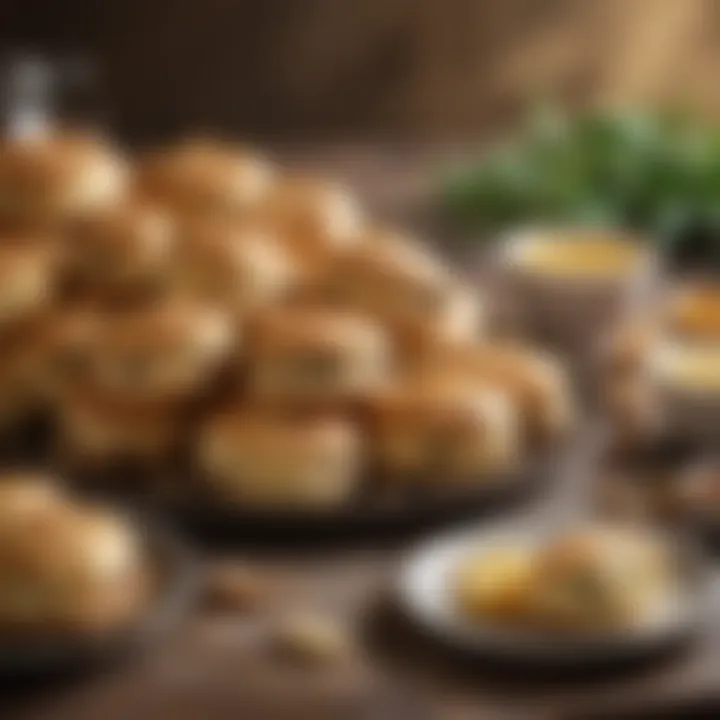
Finally, we arrive at the liquid ingredients, which are a vital player in achieving the right dough consistency. Most scone recipes call for buttermilk or heavy cream as these liquids lend a richer flavor and added fat. Not only do they form the necessary moist environment for the leavening agents to do their job, but they also help in binding the dry ingredients together.
A word of caution: adding too much liquid can lead to a sticky mess, while too little can create crumbled, dry scones. A good practice is to start with less and gradually add more until the dough comes together—patience in this process pays off.
Tip: Experiment with flavored liquids. Using herbal chai or infused teas as your liquid component can add a delightful twist to traditional scones, proving that a bit of creativity can elevate your baking.
Intertwining the right ingredients in the correct ratios is fundamental to mastering scone-making, and understanding their interplay can instill confidence in both novice and seasoned bakers alike.
Essential Tools for Scone Making
When it comes to whipping up a batch of scones, the right tools can be the unsung hero behind your culinary success. Having the proper equipment not only streamlines the process but also helps achieve the desired texture and flavor. Here’s a closer look at each essential tool you'll need to ensure your scone-making adventure goes off without a hitch.
Measuring Equipment
To kick things off, accuracy in measurement can't be overstated. Investing in a decent set of measuring cups and spoons is vital. Liquid ingredients, like milk and cream, should be measured in a transparent liquid measure with clear markings. For dry ingredients, a good scale can make a world of difference. By measuring your flour in grams rather than cups, you avoid the pitfalls of compression, which can lead to tough scones.
- Benefits of Accurate Measuring:
- Promotes consistency in results
- Prevents common baking errors
- Helps manage portion sizes
Mixing Bowls and Utensils
Next up, mixing bowls are crucial for properly combining your ingredients. A set of bowls in various sizes is handy, so you can mix, knead, and hold ingredients separately. Look for bowls made from stainless steel or glass; they’re durable and easy to clean. To mix the dough, a pastry cutter or even your fingertips can work wonders. It's all about creating that lovely crumbly texture before baking.
- Important Considerations:
- The bowl should be large enough to allow room for mixing
- Choosing materials that promote easy mixing and cleaning
Baking Sheets and Instruments
Lastly, let’s not forget about baking sheets, the cornerstone of any baking endeavor. Choose heavy-duty sheets that distribute heat evenly. Adjustable baking mats can also be beneficial as they provide a non-stick surface. Additionally, a cooling rack is necessary once those golden-brown beauties come out of the oven. This helps them maintain their texture by preventing steam from making the bottoms soggy.
"Investing in quality tools doesn’t just make baking easier; it transforms the entire experience into something far more enjoyable."
- Key Tools for Baking Scones:
- Heavy-duty baking sheets
- Non-stick baking mats or parchment paper
- Cooling racks for perfect texture
In summary, having the right tools at your disposal offers the kind of efficiency and success that make scone-making truly delightful. It's worth taking the time to gather these essentials so you can focus on the more enjoyable aspects of baking, like experimenting with flavors and creating the perfect scone!
Step-by-Step Recipe for Basic Scones with Butter
The journey to creating the quintessential scone starts here. This step-by-step recipe not only presents a hands-on approach but also fosters an understanding of each component's role in the final masterpiece. By mastering the basics of scone making, anyone can produce light and fluffy treats that pair beautifully with butter. This part of the article is invaluable as it ensures a smooth baking process, bridging the gap between concept and execution. Each step is crafted for clarity, allowing both beginners and seasoned bakers to navigate through with confidence.
Gather All Ingredients
Before you dive into the mixing bowl, you need to assemble your ingredients. This step might seem trivial, but it lays the groundwork for success. Make sure you have the following:
- Flour: All-purpose flour is often preferred, providing a versatile base.
- Butter: Look for unsalted butter, as this allows you to control the saltiness of your scones.
- Sugar: A small amount of granulated sugar adds a hint of sweetness to the scones.
- Baking powder: This is a leavening agent that ensures your scones rise properly.
- Salt: Just a pinch will enhance the overall flavor.
- Milk or cream: This will bind your ingredients together and create a tender texture.
When preparing the ingredients, it’s beneficial to weigh them—this precision can be the difference between a lackluster batch and perfection.
Preparing the Dough
Creating scone dough is less about gentle handling and more about efficiency. Start by sifting your flour, baking powder, and salt into a mixing bowl. This ensures an even distribution of the leavening agent and eliminates any lumps.
Next, cut the chilled butter into small cubes. Using a pastry cutter or your fingertips, work the butter into the flour mixture until it resembles coarse crumbs. This is crucial: some larger chunks may remain, which will create delightful pockets of butteriness in your scones.
Once the mixture resembles a sandy texture, make a well in the center. Here’s where you introduce your milk slowly, stirring with a fork until the dough starts to come together. Avoid overmixing it—just until the ingredients are incorporated. A little stickiness is a good sign; it indicates that your scones will be tender.
Shaping the Scones
Now comes the moment to give your dough form. Lightly flour your work surface and transfer the dough onto it. Gently pat the dough into a rectangle, about an inch thick. Remember, the aim is to keep as much air in the dough as possible. Using a sharp knife or a cookie cutter, cut the dough into your desired shape. Traditional scones are often round, but feel free to experiment with triangles or squares.
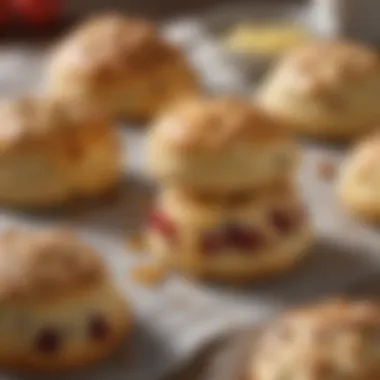
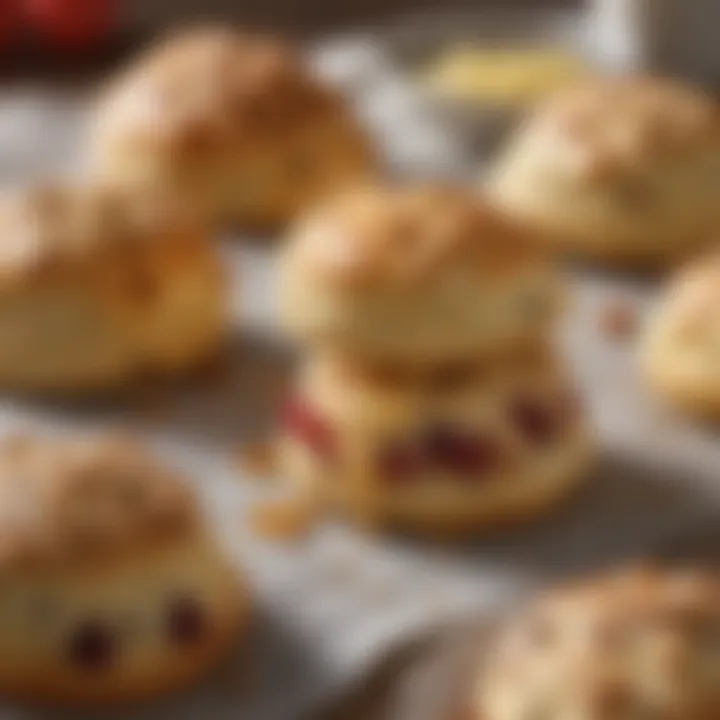
Place your shaped scones on a lined baking sheet, spacing them apart. A tip here: brush the tops with a bit of milk or cream to achieve that golden hue during baking.
Baking Techniques
Baking is an art, and mastering the oven can elevate your scones to new heights. Preheat your oven to a temperature between 400°F and 425°F, depending on how crispy you want the edges.
When placing the scones in the oven, ensure they’re spaced adequately. This allows for proper airflow, which promotes even cooking. Keep an eye on them; the magic usually happens within 15-20 minutes. Look for that lovely golden color and a delightful rise.
Once done, remove them from the oven, allowing them to cool slightly on a wire rack. This cooling ensures that they maintain their texture perfectly, giving you a deliciously warm scone that’s ready to be buttered up.
"Baking requires a delicate balance of science and artistry. Each ingredient serves its purpose, and when combined thoughtfully, they create something truly wonderful."
Flavor Variations and Additions
Flavor variations and additions play a crucial role in elevating the humble scone from a straightforward baked good to an extraordinary culinary experience. Scones, while delightful in their simplicity, offer a canvas for creativity, enabling bakers to experiment with different flavors and ingredients. By incorporating fruits, herbs, spices, and alternative sweeteners, one can personalize scones to suit any taste preference or occasion. This versatility not only enhances flavor but also invites a playful exploration of textures and aromas.
Incorporating Fruits
One of the most rewarding ways to add flavor to scones is by incorporating fruits. Fresh fruits like blueberries, raspberries, or chopped apples can introduce moisture and natural sweetness, keeping the scones tender and inviting. Dried fruits like cranberries, apricots, or figs can also work wonders, providing bursts of flavor in every bite.
When selecting fruits, consider the moisture content and acidity. For instance, berries contribute vibrant flavors and color, but they release liquid during baking, potentially making the scone too wet. A handy tip is to toss fresh fruits in a bit of flour before adding them to the dough. This technique can help absorb excess moisture, ensuring the dough maintains the right consistency.
Additionally, fruits can be paired thoughtfully; for example, lemon zest adds brightness to blueberry scones, creating a delightful contrast. To further amp up the flavor profile, think about including a fruit glaze. A simple glaze made from powdered sugar and a fruit puree can provide an appealing finish, enhancing both flavor and presentation.
Herbs and Spices
Incorporating herbs and spices into scone recipes can transform ordinary scones into extraordinary flavor sensations. Herbs like rosemary, thyme, and basil offer distinct savory notes, making them an exciting addition to scones. Imagine a rosemary-focused scone served with cheese; each bite evokes a garden's freshness paired with rich flavors.
Spices, too, can invoke unexpected warmth and depth. A hint of nutmeg or cinnamon can elevate a sweet scone, while a dash of cayenne pepper might invigorate a savory one. The key here is balance. A little goes a long way, especially in delicate scones. Too much spice can overwhelm the pastry, leading to an aromatic chaos instead of a harmonious blend. Play around with combinations: perhaps pairing cinnamon with apple or thyme with cheddar could yield delightful results.
Alternative Sweeteners
While traditional white sugar is a go-to in scone recipes, experimenting with alternative sweeteners can add a distinct character to the flavor profile. Natural sweeteners like honey, maple syrup, or agave nectar can infuse scones with unique notes.
When using liquid sweeteners, adjustments may need to be made to the other liquid components in your scone recipe. For example, if you opt for honey, reduce the milk slightly to compensate for the added moisture. Beyond flavor, these alternatives may offer additional health benefits, giving scones a wholesome twist without compromising on taste.
In sum, exploring flavor variations and additions in scone making can open up a world of culinary possibilities. From the bright tang of fresh fruit to the warm embrace of spices or the richness of alternative sweeteners, each modification carries the potential to make a simple scone a piece of art in the bakery. Experimenting with these components encourages creativity while reinforcing the endless potential of this classic treat.
Serving and Enjoying Scones
Getting into the sweet details of serving and enjoying scones adds another layer to this delightful experience. While the process of making scones is indeed a labor of love, how you present them on the table can significantly elevate their charm. A fresh batch of scones, still warm from the oven, paired with the right accompaniments can turn a simple gathering into a memorable event. So let’s dig into the delightful aspects of serving this baked treat, and explore its indulgences closely.
Cream and Jam Pairings
Pairing scones with cream and jam isn’t just a tradition; it’s a celebration of flavors that compliments the scone’s buttery richness. Clotted cream is often considered the gold standard. Its delicate texture and flavor can soothe the palate while enhancing the scone’s taste. If you find yourself wondering about the perfect jam, think fruity. Strawberry and raspberry jams add a delightful sweetness and a vibrant color to your plate.
When preparing at home, one approach is to create a tasting station. Lay out different varieties of jams, creams, or even curds — lemon curd can be a refreshing twist. This way, each guest can playfully choose their favorite combinations.
Some Popular Pairings:
- Classic Strawberry Jam: Offers a sweetness that balances beautifully with creaminess.
- Raspberry Preserve: Provides a tart contrast, which lifts the scone's flavor.
- Honey or Maple Syrup: If you prefer natural sweetness, these can unexpected delight.
It's worth noting that the temperature of your scones plays a role here. Warm scones allow spreads like cream to melt slightly, creating a beautiful blend of flavors. As the famed English proverb states, "The early bird catches the worm", likewise, the early scone enjoys the cream!
Presentation Ideas
Visual appeal is critical when serving scones. The way you present these baked goodies can stimulate the appetite even before the first bite. One delightful idea is a tiered stand—often seen in afternoon teas. Stacking different flavored scones on various levels introduces an element of sophistication.
Another approach could be to use colorful serving platters. A rustic wooden board can give a homey feel while a sleek porcelain plate conveys elegance.
Incorporating elements like fresh flowers or herbs around the scones can also enhance your display. Consider using sprigs of mint or even edible flowers that underscore the flavors within the scones. It's not only about looks; it invites an experience.
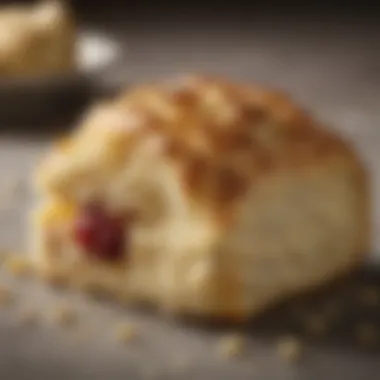
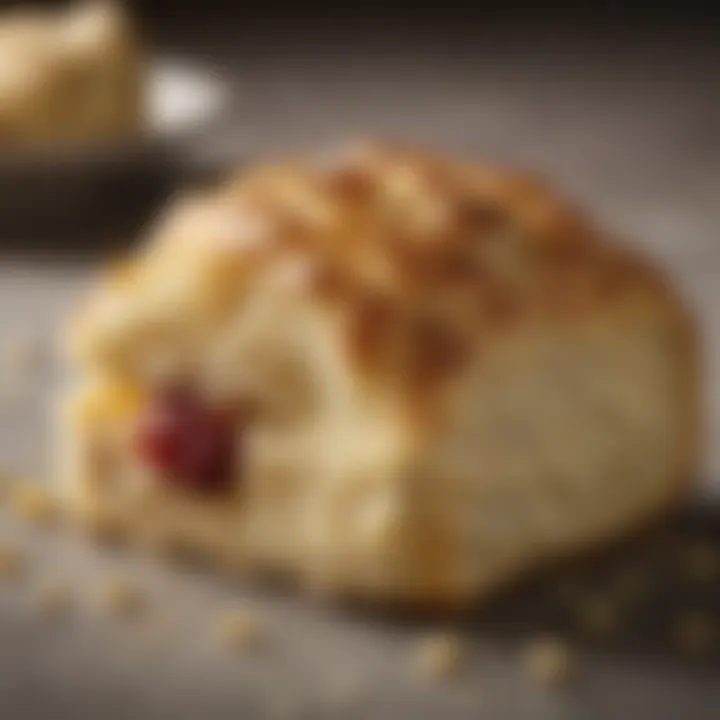
Remember, a scone is best enjoyed in an atmosphere of warmth and rich conversations.
Organizing a themed scone party with a simple yet effective color scheme can also be memorable. Choose colors that resonate with the season. Think soft pastels for spring or cozy earth tones for fall. Aligning your scone variety with the theme will surely impress your guests.
Storage and Preservation Techniques
When we bake scones, the goal is to enjoy their fresh, tender crumb and buttery richness. However, it is important to understand how to store and preserve them properly, to keep that delightful texture and taste intact for as long as possible. Knowing the right techniques can significantly enhance your baking experience and reduce wastage, particularly if you've made a sizable batch. The benefits of proper storage include prolonged shelf life, maintained quality, and a more enjoyable eating experience.
Refrigeration Tips
Placing scones in the refrigerator is a useful way to keep them fresh for an extended period without compromising flavor. Here are several key tips for effective refrigeration:
- Wrap Them Up: Before placing your scones in the fridge, wrap each one individually in plastic wrap or aluminum foil. This prevents them from drying out and absorbing any undesirable odors from other foods.
- Use Airtight Containers: Alternatively, you can place them in an airtight container. This method is excellent for keeping moisture in, which will help maintain the scones' soft texture.
- Timing Matters: Ideally, scones should be eaten within two to three days of refrigeration for top-notch flavor and texture. Beyond this, they may start turning stale, losing that delightful quality you worked so hard to achieve.
Remember, quick bites directly from the fridge can still be delightful when given a quick reheating in the oven or toaster. About five minutes at a low temperature works wonders.
Freezing for Longevity
For those who may want to stock up on scones, freezing is an outstanding option. This technique allows you to enjoy homemade goodness at your convenience. Here are some important considerations for successful freezing:
- Cool Completely: First, allow your freshly baked scones to cool completely on a wire rack after baking. This step is crucial because placing hot scones directly in the freezer can create condensation, leading to unwanted moisture and ice crystals.
- Pre-Freeze: For best results, consider pre-freezing the scones for about an hour on a baking sheet. This ensures they won't stick together once stored. After this initial freeze, you can transfer them into freezer bags or airtight containers, removing as much air as possible.
- Label and Date: Don’t forget to label your storage bags or containers with the date of freezing. This will help track how long they've been stored. Ideally, scones can be kept frozen for up to three months without significant quality loss.
- Reheating: To enjoy your frozen treasure, simply take the desired number of scones and thaw them overnight in the refrigerator. When you are ready to eat, warm them in the oven for about 10-15 minutes at 350°F (175°C). This method restores that fresh-baked feel remarkably well.
"The best way to savor scones is to think ahead in terms of storage and preservation. A little bit of foresight goes a long way in enjoying your creations at their finest."
These methods provide great ways to prevent loss of flavor or quality in your beloved scones, allowing you to always have a treat on hand for those spontaneous cravings.
Common Mistakes to Avoid
Baking scones can feel like navigating a minefield for many. The process seems simple, yet a few missteps can lead to disappointing results. In this section, we will delve into some common mistakes to sidestep when crafting scones with butter. Understanding these pitfalls not only enhances your baking skills but also ensures you achieve the delightful, fluffy texture and buttery flavor that scones are known for.
Overworking the Dough
One of the most critical aspects to consider is the handling of dough. Many bakers—both novice and experienced—have a tendency to knead the dough excessively, fearing lumps or dry patches. However, this is a recipe for disaster, quite literally. When the dough is over-mixed, gluten develops more rapidly, leading to tough and dense scones rather than the light, airy treats you’re aiming for.
The dough should be mixed until just combined. A few little lumps are perfectly acceptable, and in fact, a sign of a well-made scone. You want the dough to be soft but still maintain a certain degree of integrity without elasticity. Try to follow these tips:
- Mix gently: Use a light touch when folding in the dry ingredients with the wet ones.
- Form the dough quickly: Once mixed, shape the dough promptly, as time is not on your side. The more you handle it, the more gluten forms.
- Embrace imperfections: Accept that a rustic look is often associated with homemade scones. It adds character and charm.
"Remember, a light touch leads to light scones. Don’t work your dough too hard!"
Incorrect Oven Temperature
Another crucial error to avoid is not paying attention to your oven’s temperature. Baking is as much a science as it is an art, and having the right temperature can make or break your scone-making process.
Many inexperienced bakers set their ovens to what they think is appropriate without using an oven thermometer to confirm the actual temperature. An oven that’s too hot can cause the scones to brown on the outside while remaining raw in the middle. Conversely, a too-cool oven can lead to flat and undercooked scones. Here are some pointers:
- Invest in an oven thermometer: It's worth the few dollars to verify your oven’s actual temperature.
- Preheat thoroughly: Always ensure your oven is fully preheated before placing the scones inside. This is key for achieving that perfect rise.
- Keep an eye on cooking time: Use visual cues as well as time; you want golden tops and a firm texture.
In summary, being aware and mindful of these common mistakes can uplift your scone-making game to dizzying heights. Mastery in baking comes from understanding not only the ingredients but also the techniques and processes involved in creating perfection.
Finale: Mastering Scones with Butter
Baking scones with butter is not just about following a recipe; it embodies a journey through flavors, textures, and the heartfelt enjoyment of crafting something delicious from scratch. This guide has delved into the intricate aspects of scone making, illuminating not only the technical steps but also the artistry involved in transforming simple ingredients into a delightful treat. The importance of mastering scones lies in their versatility, serving as a blank canvas where bakers can express personal tastes and cultural heritage.
The Joy of Creativity in Baking
The act of baking can often feel like a meditative process, where time slows down, and the rhythm of mixing, measuring, and baking takes over. When it comes to scones, the possibilities are as broad as one’s imagination. Whether opting for traditional currant scones or choosing to infuse fresh herbs or spices, each variation brings a distinct flair. The ability to personalize your scones, by deciding how much sugar to use, what fruits to add, or even the butter itself, fosters a profound sense of achievement. Creativity in baking is not only fun but essential; it encourages bakers to think outside the box and turn a basic recipe into something entirely unique.
Encouragement to Experiment
Venturing into the kitchen with an open mind sets the ground for successful scone-making. While guidelines are helpful, the beauty of baking lies in embracing trial and error. Don't hesitate to swap out ordinary ingredients for more adventurous ones. Think almond extract instead of vanilla, or perhaps incorporate a hint of zesty lemon to lighten up the flavor profile.
Remember, every bake is a learning opportunity. If a batch doesn’t turn out just right, take notes on what could be altered next time—be it measuring techniques, baking times, or even the choice of ingredients. The journey towards perfect scones is paved with attempts and adjustments, and therein lies the beauty of the craft. Each time you heat that oven and mix those ingredients, you step closer to mastering not just scones, but your skills and palate as well.
As you venture forward in your baking journey, let these insights encourage you to be bold in your approach. Who knows, your next batch of scones might just be the start of a new family tradition!
"Baking is both a science and an art, and the kitchen is where genius thrives."
Embrace the joy of baking and the creativity that comes with it. Every scone you make is a stepping stone towards developing your culinary instinct, and with each successful variation, you’ll discover the scone that speaks to your palate. So, tie on that apron and let your baking spirit flourish!







